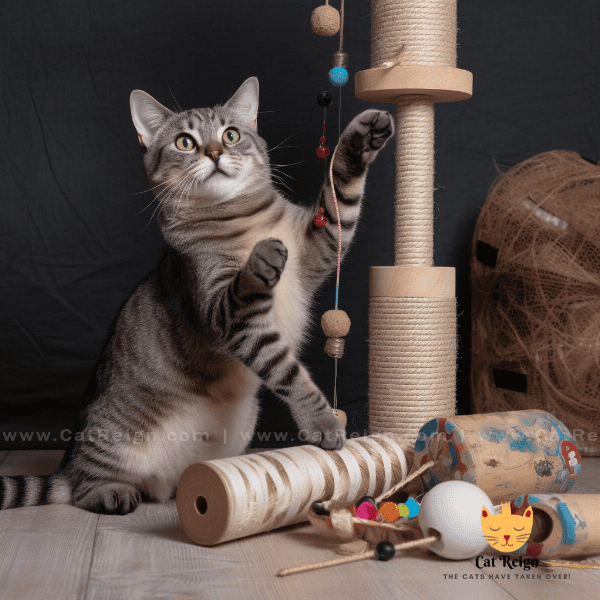Table of Contents
- Understanding the Reason Behind Cat Scratching
- Providing Alternative Scratching Surfaces
- Applying Deterrents to the Couch
- Using Double-Sided Tape as a Training Tool
- Providing Mental and Physical Stimulation for Your Cat
- Clipping Your Cat’s Nails Regularly
- Covering the Couch with a Protective Slipcover
- Seeking Professional Help from a Veterinarian or Animal Behaviorist
- Consistency and Patience in Training Your Cat
- Celebrating Your Cat’s Progress and Successes
Understanding the Reason Behind Cat Scratching
Cats are known for their scratching behavior, which can be quite destructive to our furniture, especially couches. However, understanding why cats scratch is essential to help us develop strategies to redirect their behavior.
It’s Natural Instinct
Scratching is a natural and instinctual behavior for cats. They do it to stretch their muscles, sharpen their claws, and mark their territory. Scratching also allows cats to remove the dead outer layer of their claws, exposing the new, sharp claws underneath.
It’s a Communication Tool
Cats also use scratching as a way of communicating with other cats. By leaving their scent on surfaces, they can signal their presence and mark their territory.
It’s a Sign of Stress or Anxiety
In some cases, cats may scratch excessively due to stress or anxiety. This behavior can be a sign that your cat is not feeling comfortable in their environment or that they need more mental or physical stimulation.
It’s a Habit That Can Be Changed
While scratching is a natural behavior for cats, it’s not something that can’t be changed. With patience and persistence, you can train your cat to use appropriate scratching surfaces and deter them from scratching your couch.
Understanding the reasons behind your cat’s scratching behavior is the first step in finding a solution. By providing your cat with alternative scratching surfaces and addressing any underlying stress or anxiety, you can help redirect their behavior and preserve your furniture.

Providing Alternative Scratching Surfaces
Providing your cat with appropriate scratching surfaces is an essential part of redirecting their behavior away from your couch.
Choose the Right Material
Cats have different preferences for scratching surfaces, and it’s important to find one that suits your cat’s preferences. Some cats prefer rougher surfaces like sisal or cardboard, while others prefer softer materials like carpet or fabric. Experiment with different materials to find the one that your cat enjoys the most.
Consider the Size and Shape
The size and shape of the scratching surface also matter. It should be tall enough for your cat to stretch their muscles and have a stable base to prevent it from tipping over. Providing a variety of scratching surfaces in different sizes and shapes will give your cat more options and increase the likelihood that they will use them.
Place the Scratching Surface in the Right Location
The location of the scratching surface is just as important as the material and size. Place the scratching surface in an area where your cat spends a lot of time, such as near their bed or food bowl. It should also be easily accessible and visible to your cat.
.
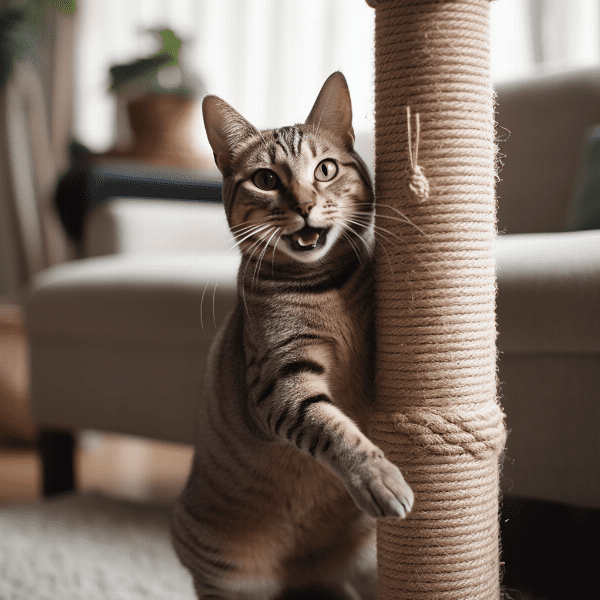
Applying Deterrents to the Couch
In addition to providing appropriate scratching surfaces, applying deterrents to your couch can help discourage your cat from scratching it.
Use Double-Sided Tape
Double-sided tape can be an effective training tool to deter your cat from scratching the couch. Cats dislike the sticky feeling on their paws and will avoid scratching surfaces with tape. Apply the tape to the areas of the couch that your cat likes to scratch, and remove it once they learn to use appropriate scratching surfaces.
Use Scent Deterrents
Cats have a strong sense of smell, and certain scents can be unpleasant to them. Apply citrus-scented sprays or essential oils to the areas of the couch that your cat likes to scratch. You can also use commercial deterrent sprays that are designed specifically for cats.
Provide Alternative Resting Spots
Cats often scratch furniture as a way of marking their territory and claiming it as their own. Providing alternative resting spots like a cat tree or a cozy bed can help redirect their need to claim the couch.
Cover the Couch with a Protective Slipcover
Covering the couch with a protective slipcover can help prevent damage from your cat’s scratching. Slipcovers are available in a variety of materials and styles, and they can be easily removed and washed.
Applying deterrents to your couch can be an effective way to redirect your cat’s behavior away from it. Remember to be consistent and patient with your training and to provide your cat with alternative scratching surfaces. By combining different strategies, you can help your cat develop a healthier and more appropriate scratching habit.
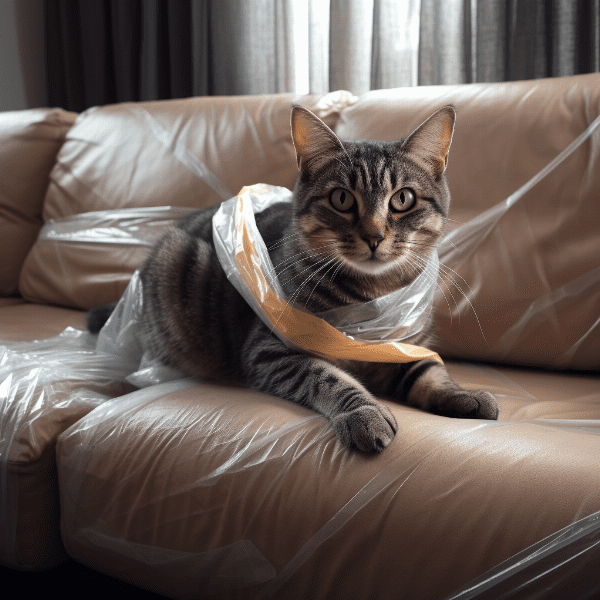
Using Double-Sided Tape as a Training Tool
Double-sided tape can be a useful training tool to help deter your cat from scratching the furniture.
How it Works
Cats dislike the sticky feeling of double-sided tape on their paws, and will often avoid surfaces with it. By applying double-sided tape to the areas of the couch that your cat likes to scratch, you can train them to use appropriate scratching surfaces instead.
How to Apply Double-Sided Tape
To apply double-sided tape, first clean the area of the couch where you will be placing it. Make sure the surface is free of any dust, dirt, or debris. Then, cut the tape to the appropriate size and shape and stick it onto the couch. You can also use painter’s tape to help hold it in place.
When to Remove the Tape
Once your cat has learned to use appropriate scratching surfaces, you can remove the double-sided tape from the couch. However, it’s important to do this gradually to avoid any setbacks in their training. Remove a small section of tape at a time, and continue to monitor your cat’s behavior to ensure they are using the appropriate surfaces.
.
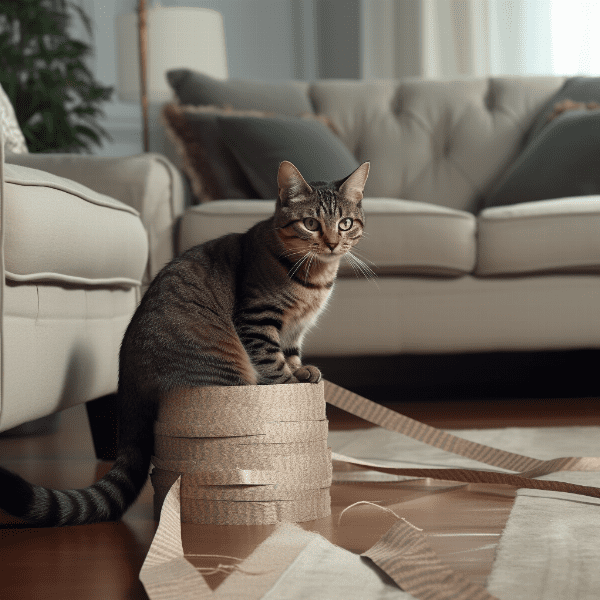
Providing Mental and Physical Stimulation for Your Cat
Providing your cat with mental and physical stimulation can help reduce their stress and anxiety and decrease their need to scratch the furniture.
Playtime
Regular playtime is essential for your cat’s mental and physical health. Provide your cat with a variety of toys and play with them for at least 20-30 minutes a day. This will help satisfy their hunting instincts and provide them with a healthy outlet for their energy.
Puzzle Toys
Puzzle toys are a great way to provide mental stimulation for your cat. These toys often require your cat to work for their food, which can help reduce boredom and stress. There are many different types of puzzle toys available, from treat-dispensing balls to complex puzzles that require problem-solving skills.
Scratching Posts with Perches
Scratching posts with perches can provide your cat with both physical and mental stimulation. The posts allow your cat to stretch their muscles and scratch to their heart’s content, while the perches provide a comfortable resting spot where they can observe their surroundings.
Window Perches
Window perches are another great way to provide your cat with mental stimulation. Cats love to watch the world outside, and a window perch can provide them with a comfortable spot to do so. This can help reduce their stress and anxiety and provide them with entertainment.
By providing your cat with mental and physical stimulation, you can help reduce their need to scratch the furniture. Remember to be consistent with your playtime and to provide your cat with a variety of toys and scratching surfaces. With time and effort, you can help your cat develop a new and healthier behavior.
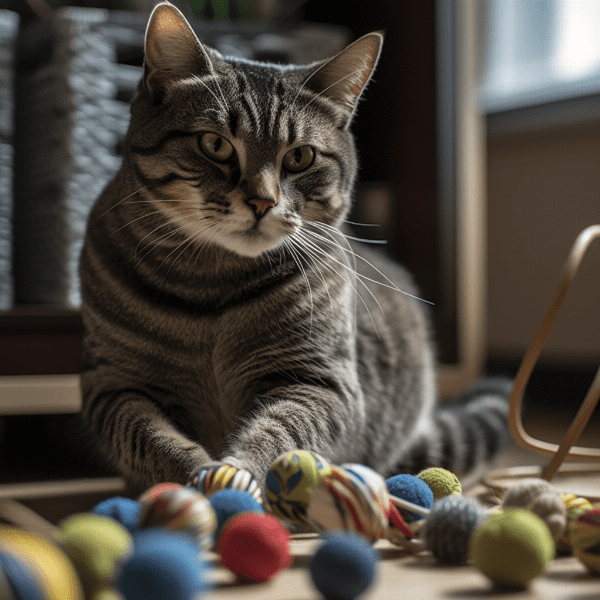
Clipping Your Cat’s Nails Regularly
Clipping your cat’s nails regularly is an important part of maintaining their health and reducing damage to your furniture.
How to Clip Your Cat’s Nails
To clip your cat’s nails, start by gently holding their paw and pressing on the pad to expose the nail. Use cat-specific nail clippers to clip the tip of the nail, being careful not to cut the quick, which is the pink part of the nail that contains blood vessels and nerves. If you’re not comfortable clipping your cat’s nails, you can take them to a groomer or veterinarian for assistance.
How Often to Clip Your Cat’s Nails
The frequency of nail clipping depends on your cat’s lifestyle and individual needs. Indoor cats may need their nails clipped less frequently than outdoor cats, who may wear down their nails naturally. As a general guideline, it’s recommended to clip your cat’s nails every 2-4 weeks.
Benefits of Clipping Your Cat’s Nails
Clipping your cat’s nails regularly can help reduce damage to your furniture and other surfaces. It can also prevent your cat from getting their claws stuck in carpet or other materials, which can be painful and stressful. Additionally, it can reduce the risk of your cat accidentally scratching you or other people in the household.
.

Covering the Couch with a Protective Slipcover
Covering your couch with a protective slipcover is an effective way to prevent damage from your cat’s scratching.
Types of Slipcovers
Slipcovers are available in a variety of materials, styles, and sizes. Some slipcovers are designed specifically for pets and are made of durable and stain-resistant materials. Others are more decorative and can be customized to match your decor.
Benefits of Slipcovers
Slipcovers offer several benefits beyond protecting your couch from scratches. They can also protect your couch from spills, stains, and other types of damage. Additionally, they can be easily removed and washed, making them a convenient and cost-effective solution.
Choosing the Right Slipcover
When choosing a slipcover, consider the size and shape of your couch, as well as the material and style of the slipcover. Look for slipcovers that are easy to remove and machine washable for convenience. You can also choose slipcovers that are designed specifically for pets, which may be more durable and resistant to scratches.
.
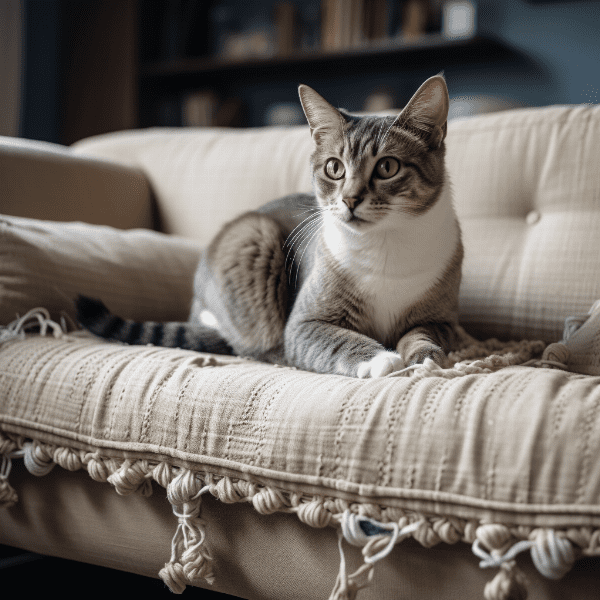
Seeking Professional Help from a Veterinarian or Animal Behaviorist
If your cat’s scratching behavior is persistent or excessive, seeking professional help from a veterinarian or animal behaviorist may be necessary.
Medical Causes
Excessive scratching can sometimes be a sign of an underlying medical condition, such as allergies, skin irritation, or parasites. A veterinarian can perform a thorough physical exam and recommend appropriate treatment if necessary.
Behavioral Causes
In some cases, scratching behavior can be related to stress or anxiety. An animal behaviorist can help identify the root cause of the behavior and develop a personalized training plan to redirect your cat’s behavior.
Medications
In some cases, medications may be necessary to help manage your cat’s scratching behavior. Your veterinarian or animal behaviorist can prescribe medication to help reduce your cat’s stress and anxiety and improve their behavior.
Other Considerations
Professional help should be sought as a last resort after other strategies have been tried and failed. Remember to provide your cat with appropriate scratching surfaces, playtime, and mental stimulation before seeking professional help. Additionally, be patient and persistent with your training and give your cat time to adjust to the new behaviors.
Seeking professional help from a veterinarian or animal behaviorist can be an effective way to manage your cat’s scratching behavior. By identifying the root cause of the behavior and developing a personalized training plan, you can help your cat develop a new and healthier behavior.
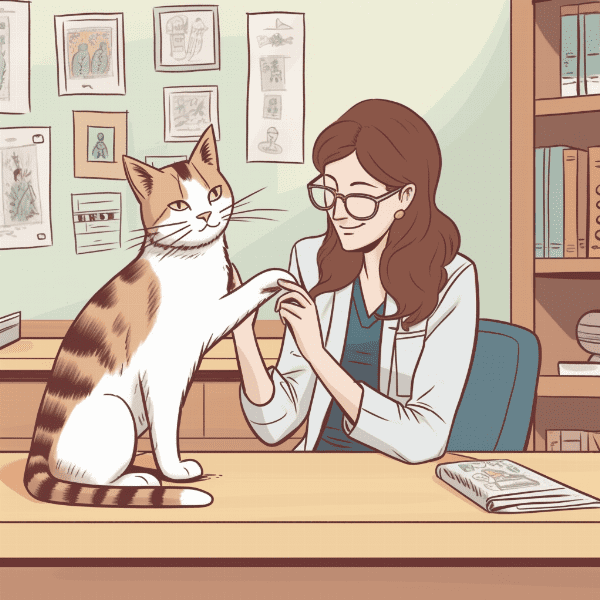
Consistency and Patience in Training Your Cat
Training your cat to stop scratching the couch requires consistency and patience. Here are some tips to help you stay on track with your training.
Be Consistent
Consistency is key when it comes to training your cat. Make sure to provide your cat with appropriate scratching surfaces and deterrents, and reward them for good behavior. Avoid punishing your cat for bad behavior, as this can cause stress and anxiety.
Be Patient
Training your cat to stop scratching the couch takes time and patience. Don’t expect your cat to change their behavior overnight. Instead, focus on small steps and progress, and reward your cat for each step in the right direction.
Use Positive Reinforcement
Positive reinforcement is an effective training technique for cats. Reward your cat for using appropriate scratching surfaces and avoid punishing them for bad behavior. Use treats, verbal praise, or toys to encourage good behavior.
Address Underlying Issues
Underlying stress or anxiety can contribute to your cat’s scratching behavior. Address any underlying issues by providing your cat with mental stimulation, playtime, and a comfortable and stress-free environment.
Don’t Give Up
Training your cat to stop scratching the couch can be challenging, but don’t give up. With consistency, patience, and the right strategies, you can help your cat develop a new and healthier behavior.
Consistency and patience are key when it comes to training your cat to stop scratching the couch. By staying on track with your training and addressing any underlying issues, you can help your cat develop a new and healthier behavior.

Celebrating Your Cat’s Progress and Successes
Training your cat to stop scratching the couch can be a challenging process, but it’s important to celebrate your cat’s progress and successes along the way.
Acknowledge Small Steps
Small steps and progress should be acknowledged and celebrated. If your cat uses an appropriate scratching surface instead of the couch, praise them and offer them a treat. This positive reinforcement will help encourage your cat to continue the behavior.
Set Realistic Goals
Set realistic goals for your cat’s training and celebrate when they reach them. For example, if your goal is for your cat to use the scratching post instead of the couch, celebrate when they achieve this behavior consistently.
Keep Track of Progress
Keeping track of your cat’s progress can help you see how far they’ve come and celebrate their successes. Take note of the behaviors that have improved and the ones that still need work, and adjust your training accordingly.
Don’t Focus on Setbacks
While setbacks can be frustrating, it’s important not to dwell on them. Instead, focus on the progress your cat has made and continue to encourage and train them.
Celebrate with Treats and Playtime
Celebrating your cat’s progress and successes can be done with treats, toys, or playtime. Set aside time each day to celebrate your cat’s successes and enjoy some quality time together.
Celebrating your cat’s progress and successes can help motivate and encourage them to continue their new and healthier behavior. By setting realistic goals, keeping track of progress, and acknowledging small steps, you can help your cat succeed in their training.


